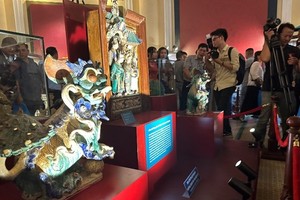 |
Nhat Tao bell remains relatively intact through thousands of years (Photo: Vietnam Pictorial) |
The bell is housed at Nhat Tao temple in Dong Ngac ward, Bac Tu Liem district of Hanoi. It is considered as a valuable antique of Thang Long-Hanoi in particular and Vietnam at large.
The antique has been mentioned in a number of studies in culture and history of Vietnam, given that it is the sole antique made in the 10th century whose unique shape is different from others in pagodas and temples in Vietnam.
Decorative patterns on the bell demonstrate the quintessence of sculpture and cooper casting in the past. The poem carved on the bell is viewed as among the earliest historical documents in the form of writing made during the country’s independence time.
The bell measures 6kg in weight and 32cm in height. The diameter of its mouth is 19cm and of its canons, 7cm. It remains relatively intact through thousands of years.
A pair of mythical creatures was cast on the bell’s canons, with their backs turning against each other. The creatures have large heads, googled eyes and mane, and scales all over their bodies.
The top of the canons is a flat and round piece instead of the shape of gourd like that of other bells made in later periods.
The cup-shaped bell has a flat crown. Its core has eight areas, with the upper part containing four trapeziums and the lower part four rectangles.
Ancient Chinese characters were inscribed on the outer wall of the bell. The 211 characters were presented in 27 columns.
The bell was described in an official document dated in 948, which serves as a historical resource of great importance for studies on the Vietnamese society in early independent period. It also gives an insight into culture and social and political situations in Vietnam during the Ngo dynasty (939 to 965). The dynasty was founded by Ngo Quyen, who led Vietnamese forces in the Battle of Bach Dang River against invaders in 938.
Late Professor Ha Van Tan translated the characters inscribed onto the bell to modern Vietnamese language as: Lower Tu Liem village, Giao Chi district, the 29th day of the fourth lunar month in the Year of the Monkey (June 9, 948 in Gregorian calendar).
Protégées of two sects in Taoism and Confucianism, in the Year of the Dragon (944) raised money to draw a painting of a dignitary. Then together they bought a valuable bell weighing 15kg to honour the predecessor.
The document mentions the Year of Dragon (944), which was the time Ngo Quyen passed away. This showed that although Ngo Quyen proclaimed independence and ascended to the throne, he had yet to decide on an era name.
The document also gives an insight into the history of villages and religions, especially Taoism in the spiritual life of Vietnamese in the 10th century. It is also the first and only document to date that reflects the relations between Taoism and Buddhism in the spiritual life of Vietnamese during the Ly dynasty (1009-1225) and the Tran dynasty (1225-1400).
The characters on the bell help researchers understand that the local administrative system of communes, villages and districts was set up early in Vietnam, along with titles of Taoism, in the 10th century. Communes could be a religious organisation and an administrative unit at the same time.
Nhat Tao temple is home to 26 ordinances of Vietnamese kings, together with the ancient bell. Of these, 21 were officially recognised, with the first dated in 634.
Nhat Tao villagers annually hold a celebration to mark the death of the temple’s head in the ninth lunar month of the year, its festival on the 11th and 12th day of the second lunar month.
On such occasions, Nhat Tao bell is on display to honour tutelary god of the village, which also helps people and tourists understand more about Nhat Tao, an ancient land of more than a thousand years.
























